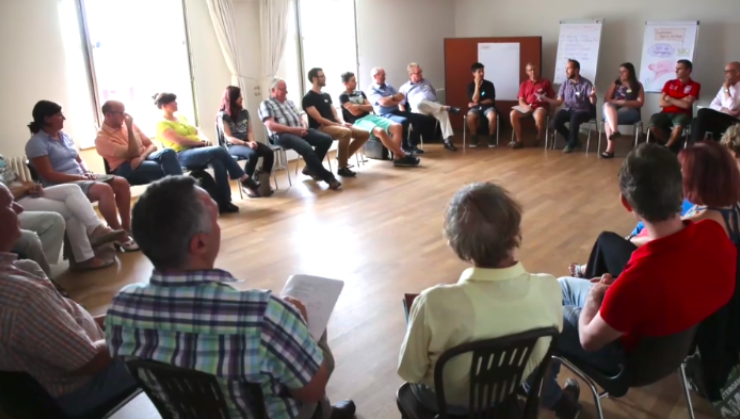Key Resources for Co-Creativity:
An evolving field of practice
An expanding multiverse of ways for humans to be creative and effective together
Open Space Technology… Circle Practice… World Cafe… Future Search… Art of Hosting… Appreciative Inquiry… Restorative Circles… and more. I am deeply grateful for the various dialogic methods and approaches that have helped to shape my work.
Since the year 2000, I’ve been diving deeply into learning, practicing, teaching, and writing about another valuable member of this growing family. Dynamic Facilitation offers a creative approach for exploring complex and difficult issues.
Created by quality improvement consultant Jim Rough, this work is currently taught in Germany by Matthias zur Bonsen and others. Especially appropriate for working with polarizing or “impossible-to-solve” challenges, its outcomes include shared systemic understandings, high group energy and commitment, and new creative possibilities. In addition, a strong sense of “we” usually arises from the process of engaging deeply with diverse perspectives.
This English-language google doc offers an update on recent DF developments in the German-speaking world.
Dynamic Facilitation is a key ingredient in the Wisdom Council Process, also created by Jim Rough. This creative format supports organization-wide learning by surfacing “corporate elephants” in a constructive and engaging manner. We start with a microcosm group that later reports out to the larger system.
The 6-min video above by Franziska Espinoza shows a Wisdom Council process at Swisscom. Here is a chapter that Matthias zur Bonsen wrote about how we can use this approach to support organizational learning.
This creative, deep-listening based approach has been shown to be effective in both business and public contexts. In the business world, Dynamic Facilitation can be especially helpful when working with boards, management teams, cross-functional teams, and across silos. This article in OD Practitioner illustrates some of these applications.
_________________________________________
Deep listening and creativity in the civic realm
The Vorarlberg Bürgerrat model (Citizens’ Council) adapts and elaborates on Jim Rough’s Wisdom Council process, and includes both Dynamic Facilitation and the World Cafe. This model has been used in Austria since 2006 to facilitate public participation in democratic policy-making.
Click on the photo above to see a brief 6-minute overview video on an award-winning Bürgerrat in Vorarlberg, Austria. This particular Council was convened to address the challenging issue of the growing influx of refugees and asylum-seekers. Video by Martin Rausch.
The video does a better job than a still photo ever could, of capturing the spirit of these Councils. To further convey that spirit, here’s a recent article on “Dancing with Agile Deliberation“, inspired by Rosa’s qualitative research interviews with practitioners who facilitate these Councils.
_______________________________________
Our mission at DiaPraxis is to develop societal capacity for bridging divides, working creatively with diverse perspectives, and arriving together at powerful shared truths.
We are committed to on-going learning, and to sharing what we learn with others. Thus, we love teaching Dynamic Facilitation as part of our workshops on Hosting and Harvesting Complexity with Heart, and we have garnered some lovely reviews from participants.
Learn more about how this approach to participatory democracy is being used in Europe.
Rosa’s writings on Agile Deliberation, Dynamic Facilitation, and more
Various authors on Dynamic Facilitation
______________________________________
The Co-Intelligence Framework
Tom Atlee, founder of the Co-Intelligence Institute (CII), has written The Tao of Democracy, Empowering Public Wisdom, Reflections on Evolutionary Activism, and Participatory Sustainability. His older legacy website includes a wealth of essays, resources, stories, and links on how co-intelligence can be enhanced and woven into our cultures.
Tom created the inspiring Wise Democracy Pattern Language (WDPL) in collaboration with Martin Rausch. This website includes a beautiful set of WDPL cards that can be either purchased or downloaded freely for DIY.
Both the co-intelligence framework and the Wise Democracy pattern language are forms of grounded theory, which have emerged from Tom’s ongoing exploration of countless examples of leading-edge practice.
_______________________________________
Last but not least, here’s another page with additional resources for supporting co-intelligence and co-creativity, including great links to the Fetzer Institute’s Collective Wisdom Initiative, Dialogue Mapping, Empathy Circles, Dr. Saul Eisen’s work, and more…
